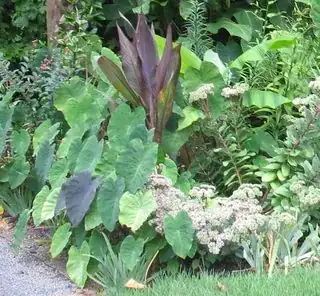When I look at Elephant Ear varieties in plant catalogs, they all say Elephant Ears are hardy in zones 9-10, sometimes 7-10. But I see people in my area, zone 6b, growing them outdoors without winter protection. Are they growing special varieties or are most catalogs being overly safe?
2 Answers
You're on the cusp of being able to overwinter some varieties of Elephant Ear, Colocasia. I found what you did, that of the very cold hardy varieties, zone 7 is pretty much the lowest advertised.
However, there is one variety that keeps coming up as being hardy enough for you. As Tim said, it's the Colocasia 'Pink China'. A number of nursery catalogs and anecdotal articles recommend it as the one to try in zone 6. I even found a few that have grown it successfully in zone 5.
Here's a sampling from my research. Some are redundant, and are listed just to give examples.
Cool Colocasias, Elephant Ears for the Garden, from Plant Delights Nursery in Raleigh, North Carolina, is a great resource for care of Colocasias in general, and features a comprehensive list of different varieties with pictures.
Colocasia esculenta 'Pink China' is an introduction from Kentucky's Brian Williams, and has been the hardiest elephant ear in his trials, with tubers left on top of the ground surviving outdoors in Kentucky. We have heard unverified reports of hardiness in warmer Zone 5, but we'll believe it when we see temperature documentation. Regardless of the hardiness, Colocasia 'Pink China' makes an attractive 4' tall clump that spreads rapidly by rhizomes to create a large patch. The green leaves are held atop mauvy-pink stems. (Hardiness Zone 6-10)
Colosiaplants.com is also a good general resource. From the detailed section on overwintering:
Most Colocasia has a solid USDA Hardiness Zone 7b, while Colocasia 'Pink China' is reportedly winter hardy to Zone 6.
Knollwood Gardens in Ohio:
Colocasia 'Pink China'
A very pretty variety with vibrant pink stems, it grows to 4-6 feet. It is a fairly cold-hardy variety to Zone 6 (we are Zone 5 in most cases).
The Manchester Garden Club in Indiana includes it with other plants on their page called "Hardy Tropicals for Zone 5"
Colocasia Esculenta Pink China
This elephant ear is reportedly as hardy as Musa Basjoo (the Japaneses Fiber Bannana) and it looks great planted under the banana tree. The plant has medium green leaves, but it is easily identified by the pink dot in the center of the leaves. The stems also are very pink in color at times, but not quite so bold at other times. The tubers spread like crazy and one plant may easily turn into 25 in one summer.
This is a must have for anyone trying to grow tropicals in cold zones. It has easily survived several Zone 5 winters here with no protection, although the survivors don't tend to get quite as big as the ones overwintered in a garage, which can achieve 5 to 7 feet in height. This elephant ear really multiplies in the sun, but it will do just fine in part shade and actually have better color.
Logee's Nursery in Connecticut.
Elephant Ear ‘Pink China’ (Colocasia hybrid) has brilliant pink stems and rich green leaves with a pink dot in the center to add vibrant color to any container or garden. Possibly the hardiest of all colocasias, 'Pink China' can tolerate zone 6 with a heavy layer of mulch as winter protection. It makes the perfect tropical plant for people in colder zones who don't want to move plants inside for the winter. 'Pink China' generally reaches 4' tall the first season and it spreads by underground rhizomes creating a larger display with each subsequent year.
The Wholesale Elephant's Ears catalogue, in California
Elephant Ears Colocasia Esculenta "Pink China" is known to be the hardiest Elephant Ear variety. With proper mulching, it can even thrive in zone 6. Pink China has dusty green leaves and gorgeous shocking bright pink stems. The pinkish purple hues extend to the under side of some leaves.
Although I'm on the East Coast of the United States, I live in pretty much the same zone as you, and we sometimes have unusually mild winters. I imagine you do too, so if you're willing to take a risk, I'd try this lovely looking variety. If you start to see too many dying off, you can dig up some of the tubers (rhizomes) and move them inside the garage or house (if the plant's not too big) for the winter. According to most of what I've read, transplanting is not too difficult, especially among the smaller varieties.
Click on pictures for larger view.
- 6,215
- 8
- 39
- 74
The Pink China Elephant Ear is supposed to be hardy to zone 6. I have not grown it myself though.
- 6,215
- 8
- 39
- 74
- 1,056
- 2
- 10
- 19
-
Hi Tim! I just noticed that this reference links to a removed page. I was going to switch it for you but didn't know what you'd pick. – Sue Saddest Farewell TGO GL Dec 31 '16 at 20:41
-
@Sue Feel free to use your best judgement. Looks like you linked to a google image search in your answer. I'm not sure what the right thing to do is for something like this, for stack exchange. – Tim Jan 03 '17 at 22:22
-
I replaced it with one I used in my answer. It has a picture, care information, and lists it as hardy to zone 6. It's probably similar to the one you had before. – Sue Saddest Farewell TGO GL Jan 03 '17 at 22:49

